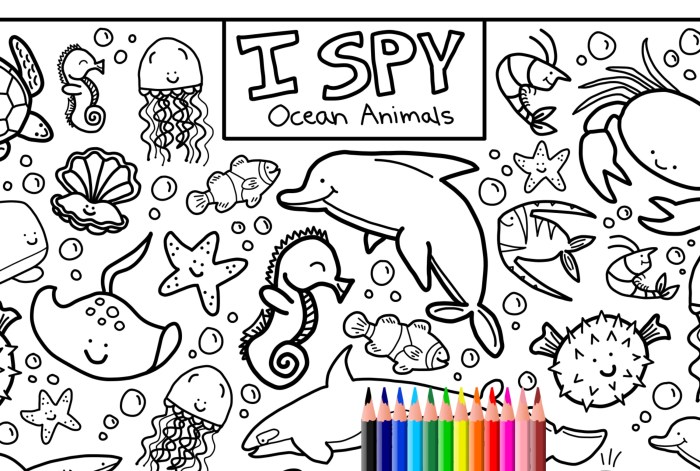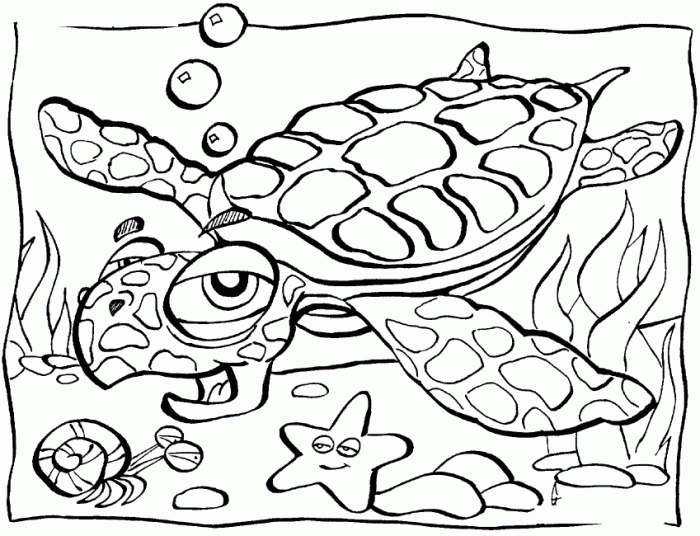Popularity and Trends of Ocean Animal Coloring Pages

Ocean animals coloring pages printable – Ocean animal coloring pages enjoy widespread popularity, appealing to a broad range of ages and artistic inclinations. Their enduring appeal stems from the inherent fascination with marine life, coupled with the relaxing and creative benefits of coloring. Current trends reflect this popularity, showcasing evolving designs and a focus on diverse styles to cater to various preferences.Ocean animal coloring pages are a consistently popular choice for printable activities, reflecting a sustained interest in marine life and creative expression.
Their popularity is influenced by several factors, including the readily available resources online, the accessibility of the activity, and the diverse range of designs catering to different age groups and skill levels. The ongoing trends within this market reveal a dynamic and evolving landscape of creative options.
Current Trends in Ocean Animal Coloring Page Designs
Current trends show a move towards more intricate and detailed designs, incorporating elements like realistic textures and patterns. There’s also a growing popularity of themed coloring pages, such as those focusing on specific ocean habitats like coral reefs or the deep sea. Furthermore, many designs now incorporate elements of mindfulness and relaxation, featuring calming color palettes and intricate details to promote a meditative coloring experience.
For example, a recent trend involves incorporating mandalas or other geometric patterns into the designs of ocean animals, combining the appeal of marine life with the meditative practice of mandala coloring. Another example is the increasing use of watercolor-style designs, encouraging a more fluid and expressive coloring approach.
Most Popular Ocean Animals Featured
Several ocean animals consistently rank high in popularity for coloring pages. Dolphins, with their playful nature and recognizable features, are perennial favorites. Similarly, whales, particularly orcas and humpback whales, are popular due to their majestic size and captivating appearance. Sea turtles, known for their gentle nature and striking shells, also frequently appear. Colorful fish, such as clownfish and angelfish, are popular choices, especially among younger children.
Finally, sharks, despite their often fearsome reputation, also feature prominently, possibly due to their powerful and dynamic presence.
Comparison of Realistic vs. Cartoonish Styles
The popularity of realistic versus cartoonish styles varies depending on the target age group. Younger children often gravitate towards cartoonish, simplified designs that are easier to color and feature exaggerated, appealing features. Older children and adults, however, often prefer more realistic designs that offer a greater challenge and allow for more nuanced coloring techniques. Realistic designs often showcase intricate details of the animal’s anatomy and environment, while cartoonish designs emphasize playful expressions and simplified shapes.
For example, a realistic dolphin coloring page might feature detailed textures of its skin and the ripples of the water, while a cartoonish version might have simpler shapes and exaggerated features, such as oversized eyes and a playful smile.
Age Groups Most Likely to Use These Coloring Pages
Ocean animal coloring pages appeal to a wide range of ages. Younger children (preschool to early elementary school) benefit from the large, simple designs that help develop fine motor skills and color recognition. Older children (elementary to middle school) enjoy more complex designs that challenge their artistic abilities. Adults also find these coloring pages to be a relaxing and creative outlet, offering a stress-relieving activity that allows for self-expression.
The flexibility of the activity allows for adaptation across age groups, making it a versatile and widely enjoyed pastime. For instance, a simple, bold Artikel of a fish is perfect for a preschooler, while a detailed rendering of a coral reef teeming with various species would appeal to a teenager or adult.
Dive into a world of underwater wonder with our ocean animals coloring pages printable! Unleash your creativity with vibrant hues, bringing playful dolphins and majestic whales to life. For even more amazing animal adventures, check out these fantastic wildlife animal coloring pages featuring land creatures too! Then, get back to those ocean depths and color your way to an underwater masterpiece with our printable ocean animal pages – it’s a coloring adventure you won’t want to miss!
Design Elements and Artistic Styles

Ocean animal coloring pages cater to a wide range of ages and artistic preferences, resulting in a diverse array of design elements and styles. The complexity and style of the artwork directly impact the level of engagement and the overall coloring experience. Understanding these design aspects is crucial for creating appealing and age-appropriate coloring pages.
Artistic Styles in Ocean Animal Coloring Pages
Ocean animal coloring pages employ various artistic styles, each contributing to a unique visual appeal. Simple line art, characterized by clean lines and minimal detail, is ideal for younger children, allowing for easy coloring and fostering creativity without the pressure of intricate designs. In contrast, intricate styles feature detailed textures, shading suggestions, and complex patterns, offering a more challenging and rewarding experience for older children and adults.
Some pages may even incorporate elements of realism, mimicking the appearance of actual ocean animals with greater accuracy. Other styles might lean towards a more cartoonish or whimsical aesthetic.
Color Palettes for Ocean Animals
The choice of color palettes significantly influences the overall mood and realism of the coloring page. For instance, a realistic depiction of a coral reef might utilize vibrant hues of blues, greens, yellows, and oranges, reflecting the natural vibrancy of the underwater environment. A playful portrayal of a cartoonish octopus, however, might employ bolder, less realistic colors like bright purple, lime green, and electric blue.
Subtle gradients and shading can add depth and dimension, while monochromatic palettes offer a calming and sophisticated approach. The selection of colors should always be carefully considered to enhance the chosen artistic style and target age group.
Design Approaches for Different Age Groups
Design considerations vary significantly depending on the target age group. Toddlers benefit from simple, large-scale designs featuring bold Artikels and limited detail. These designs allow for easy coloring within the lines and promote hand-eye coordination. Older children, on the other hand, appreciate more intricate designs with smaller details, allowing for greater creativity and expression. Teenagers and adults may enjoy highly detailed, realistic, or even mandalas featuring ocean animals, providing a challenging and engaging coloring experience.
Examples of Design Approaches
| Animal | Style | Color Palette | Age Group |
|---|---|---|---|
| Clownfish | Simple Line Art | Bright Orange, White, Black | Toddlers |
| Dolphin | Semi-Realistic | Gradients of Blues and Grays | Older Children |
| Sea Turtle | Intricate, Detailed | Greens, Browns, Yellows | Teenagers/Adults |
| Seahorse | Whimsical, Cartoonish | Pastel Blues, Pinks, Purples | All Ages |
Educational Value and Benefits: Ocean Animals Coloring Pages Printable

Ocean animal coloring pages offer a surprisingly rich tapestry of educational benefits, extending far beyond simple entertainment. They provide a fun and engaging way for children to learn about marine life, develop crucial skills, and foster a sense of wonder about the underwater world. The act of coloring itself contributes significantly to cognitive and physical development, making these pages a valuable tool for both parents and educators.Coloring pages featuring ocean animals can be a powerful educational tool.
They provide a visual introduction to a diverse range of marine species, allowing children to learn about their appearances, names, and even basic characteristics. For instance, a coloring page depicting a vibrant clownfish alongside a majestic whale shark immediately introduces the concept of size and habitat differences. Similarly, pages depicting different types of coral reefs can help children understand the complexity and importance of these ecosystems.
By associating specific colors and shapes with particular animals, children build a visual vocabulary that strengthens their understanding of marine biodiversity.
Fine Motor Skill Development and Hand-Eye Coordination
Coloring actively engages fine motor skills. The precise movements required to stay within the lines, color accurately, and control the pressure exerted on the crayon or colored pencil strengthens small muscles in the hands and fingers. This improved dexterity translates to better handwriting, drawing ability, and overall manipulative skills. Furthermore, the coordination needed to match colors to designated areas on the page enhances hand-eye coordination, a skill essential for many everyday activities.
The repetitive action of coloring also improves focus and concentration. For example, a child meticulously coloring the intricate details of a seahorse’s tail is developing precision and control, vital for future writing and drawing tasks. The challenge of staying within the lines provides valuable practice in self-regulation and task completion.
Incorporating Learning Elements into Design, Ocean animals coloring pages printable
The design of ocean animal coloring pages can be strategically enhanced to maximize their educational impact. For instance, including labels next to the animals, their names, and perhaps a few key facts (e.g., “The sea otter uses tools to find food!”) can transform a simple coloring activity into a learning experience. Similarly, incorporating simple maps showing the habitats of different animals or creating pages with a focus on a specific ecosystem (like a coral reef or a kelp forest) provides context and expands the learning experience beyond individual species.
A coloring page featuring a food chain, with arrows illustrating predator-prey relationships, can introduce ecological concepts in an engaging way. Another example would be including a small section with simple questions related to the image, prompting children to think critically about what they see. This multi-faceted approach ensures that coloring pages become interactive learning tools.
Clarifying Questions
What paper is best for coloring ocean animal pages?
Heavier weight paper, such as cardstock, is recommended to prevent bleed-through, especially with markers or watercolors. Thinner paper may require backing.
Where can I find free printable ocean animal coloring pages?
Many websites and online resources offer free printable coloring pages featuring ocean animals. A simple online search should yield numerous results.
Are there coloring pages suitable for adults?
Yes, many designs incorporate intricate details and complex patterns, making them suitable for adult coloring enthusiasts.
How can I incorporate these pages into a classroom setting?
These pages can be used for lessons on marine biology, art class activities, or as a calming reward system.
